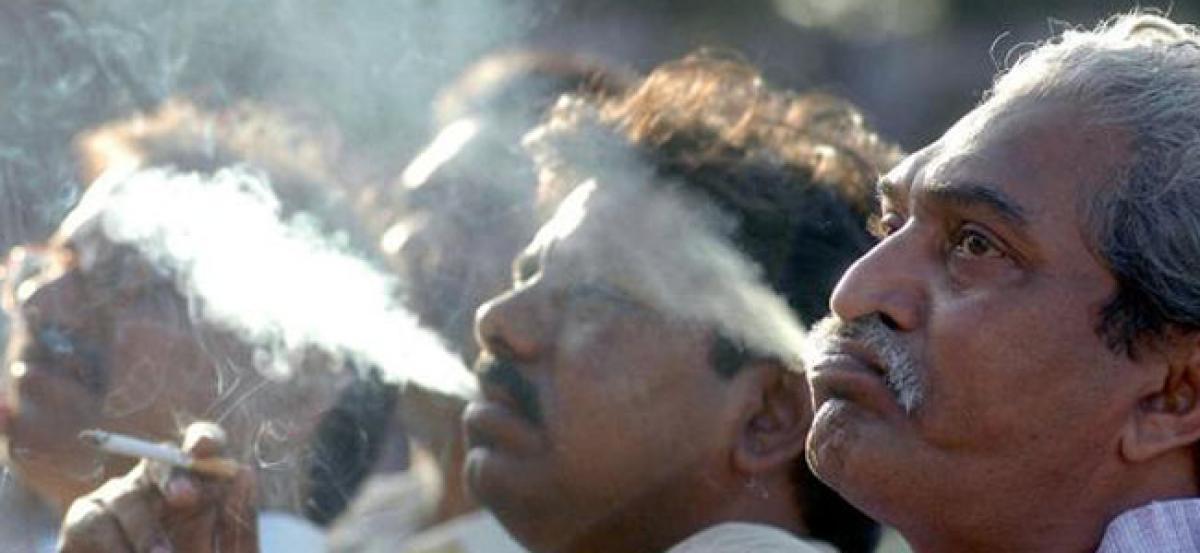Live
- Keerthy Suresh to get engaged soon!
- CM A. Revanth Reddy Performs Special Rituals In Vemulawada
- Revanth Reddy Criticizes Bandi Sanjay and KCR Over Lack of Development in Karimnagar
- Major Scam Uncovered in Cyberabad; 3,600 Victims
- President Droupadi Murmu to Visit Telangana Tomorrow
- Strengthening Your Immune System: The Ultimate Guide to Boosting Defenses Naturally
- AP cabinet meeting begins, to Approve crucial decisions
- Pawan Kalyan all praise for Chandrababu Naidu in Assembly Speech
- Special teachers will continue to serve in their schools, assures Nitish Kumar
- South Korea: CFC deputy commander to visit US this week to discuss military cooperation
Just In

Fewer Indians used tobacco in 2015-16 than a decade ago, but only China consumes and produces more tobacco, keeping cancer rates high, according to the latest national health data.
Fewer Indians used tobacco in 2015-16 than a decade ago, but only China consumes and produces more tobacco, keeping cancer rates high, according to the latest national health data.
Tobacco consumption in India is the highest in the six northeastern states of Mizoram, Meghalaya, Manipur, Nagaland, Tripura and Assam: On average, 70.7 per cent men here use tobacco in some form or the other, according to data from the National Family Health Survey 2015-16 (NFHS-4). This figure is 26 percentage points higher than the national average.
Mizoram tops the northeast list, with 80.4 per cent men and 59.2 per cent women between 15 and 49 years consuming tobacco. When ranked for men using tobacco, it is followed by Meghalaya (72.2 per cent), Manipur (70.6 per cent), Nagaland (69.4 per cent), Tripura (67.8 per cent) and Assam (63.9 per cent).
At 37.7 per cent, the female average for tobacco users in Manipur, Tripura, Meghalaya and Nagaland was way above the national average of 6.8 per cent. The northeastern states also report a higher risk for cancer 112 men and 60 women of 1,000 die of cancer here while the national average is 47 for men and 44 for women, according to the 2012 Million Death Study published in The Lancet.
Tobacco use is one of the main risk factors for a number of chronic diseases, including cancer, lung diseases and cardiovascular diseases. And not just in the northeast, elsewhere too millions of Indians continue to be vulnerable to these diseases.
The latest national average for tobacco consumption, according to NFHS-4 – 44.5 per cent men and 6.8 per cent women is lower than 2005-06 figures. Tobacco use has fallen in India – by 12.5 percentage points for men and four percentage points for women over a decade.
But India is still the second-highest producer and consumer of tobacco, according to National Tobacco Control Programme. In 2011, the total cost of dealing with diseases related to tobacco use among the 35-69 age group amounted to Rs 1.05 lakh crore ($22.4 billion). This is 1.16 per cent of GDP and 12 per cent more than the combined state and central government expenditure on healthcare in 2011.
The survey also shows that 29.3 per cent female and 30.6 per cent male tobacco users in the 15-49 age group tried to wean themselves off tobacco in the 12 months preceding the survey. In Mizoram, tobacco use has fallen by 1.6 percentage points and three percentage points for women and men, respectively, since 2005-06.
Punjab and Puducherry with 19.2 per cent and 14.4 per cent, respectively, recorded the lowest use of tobacco among men. Fewer than one per cent women in the 15-49 age group use any kind of tobacco in Himachal Pradesh, Daman & Diu, Kerala, Chandigarh and Puducherry.
Both men and women (between 15 and 49 years of age) use more tobacco in India's villages than its cities. Among urban women, 4.4 per cent use it compared to the 8.1 per cent women in villages. For men in villages, the figure is 48 per cent and in cities, 38.9 per cent.
Even on the question of trying to go off tobacco, more urban women users (33 per cent) make an effort than women users in villages (28.2 per cent). But the trend is reversed for men: 31.2 per cent male tobacco users in villages and 29.6 per cent in cities tried to wean themselves off tobacco.
Not a single state has more than 50 per cent of male and female tobacco consumers (in the 15-49 age group) attempting to quit consumption of tobacco in any form in 12 months preceding the survey. The number of those using smokeless tobacco (25.9 per cent) is almost double that of those who smoke (14 per cent), according to Global Adult Tobacco Survey 2009-10.
"Tobacco is responsible for nearly 50 per cent cancers in India and 90 per cent of mouth cancers. Half of the mouth cancer patients die within 12 months of diagnosis," said Pankaj Chaturvedi, professor and surgeon at the Tata Memorial Hospital in Mumbai.
Tobacco caused 42 per cent of all cancers in men and 18 per cent of all cancers in women, according to the Million Death Study. In all, tobacco caused 120,000 cancers with twice as many oral cancers as lung cancer. This highlights the high prevalence of tobacco chewing in India.
"Raising taxes on tobacco products is an evidence-based tool to reduce tobacco use. We appeal to the government to levy highest Goods and Services Tax on all tobacco products, including beedi," said Michelle Reyes, an expert with the International Union Against TB and Lung Disease, in a statement released on the eve of the International Tobacco Day. (In arrangement with IndiaSpend.org)
By Ojaswi Rao

© 2024 Hyderabad Media House Limited/The Hans India. All rights reserved. Powered by hocalwire.com







